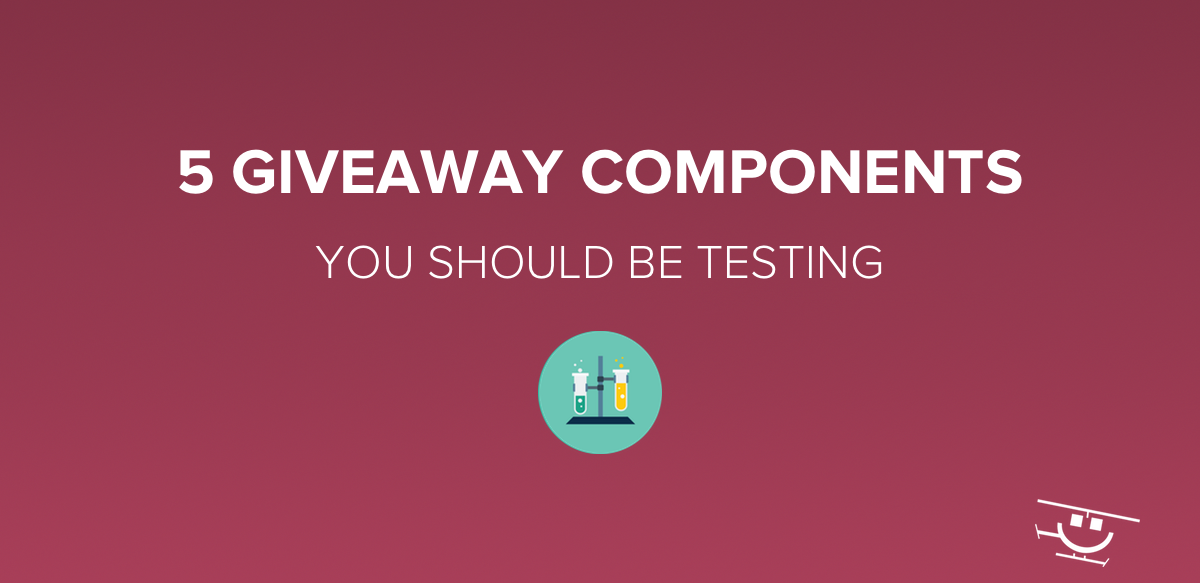
Reflecting on the success of your giveaways is important to your long-term strategy. Asking the right questions will help you finesse your process and figure out what works with your audience.
Was the participation low because your prize was lame? Could you have improved the design of the widget to make it more attractive? What did you do to promote the giveaway?
Creating a giveaway with Rafflecopter is easy-breezy, but it’s a robust marketing tool that should be given proper thought. And as with any marketing tool, testing is essential to the process. Below are five components that can be tested from one giveaway to the next.
Component #1: The Prize
If you pulled something out of the back of your closet and thought you found your next prize, you’ll want to rethink that. While it may have been White Elephant gold, you’re in competition with thousands and thousands of other giveaways. You have to up the ante.
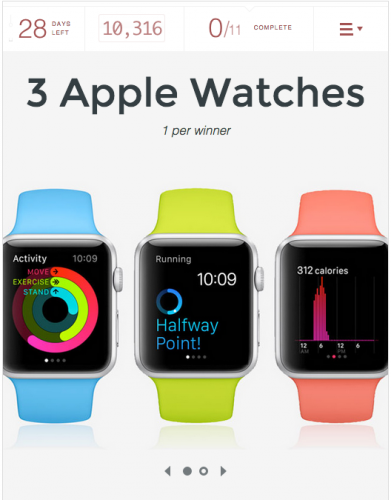
Prize Value – Step one – read our Giveaway Field Manual article about prize selection. The best performing prizes are at least two-hundred dollars in value and are of interest to most people. Not everyone is going to be into a gluten-free cookbook, but a Vitamix? Game on.
Prize Type – We have a good mixture of gift card and product/service giveaways running throughout the year. Both of them can perform well for the hosts, but it takes some trial and error. If your product giveaways aren’t hitting your goals, you can try running a giveaway with a gift card to your online store.
This way the winner has access to your whole collection, and it adds to the excitement of the giveaway since they’ll be able to select exactly what they want. If all else fails, try an Amazon gift card. People love Amazon.
Prize Image – What’s up with the pixelated image? Before you even test the subject of the image, you’ll want to perfect the quality. People are visually driven, so this is essential to your giveaway’s success. Now that we have the image quality PSA out of the way, let’s talk about the image subject.
Have you been sticking to your standard product line image? Maybe it’s better to include a lifestyle image of a person using your product. What if you tried a close-up, standalone image highlighting the quality packaging and product features? It’s worth a test.
Component #2: The Entry Options
This is the ‘barrier to entry’ portion. How difficult do you make it to enter your giveaways? Are you requiring all entrants to tweet a message excluding everyone who doesn’t use Twitter? Some people aren’t down to complete ten entry options. If you’re seeing low engagement, this is a good area to reconsider.
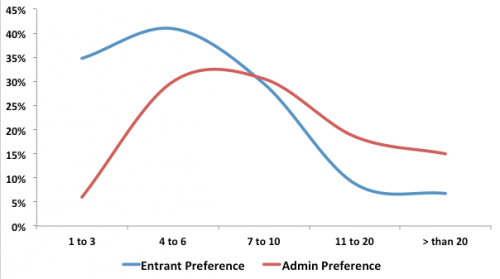
Entry Number – We recommend using between three to six entry options. Some hosts run giveaways with twenty entry options that do well for their audience. Others look at the giveaway and think “that’s too much work” and move along. Test it out with your audience to see what converts.
Entry Type – We’ve had entrants write in and say “I want to enter x giveaway, but the only entry options involve Twitter. I don’t use Twitter, so what do I do?” If the whole purpose of your giveaway is to increase Twitter followers, then of course, only focus on Twitter. But, if you’re trying to broaden your reach, add some variety.
Some giveaways only use the social media entry options, while others get creative and use the ‘invent your own’ entry option. It depends on the goals of your giveaway. Maybe you see great social engagement with the Facebook and Twitter entry options, but now you’d like to learn a little more about your customer base. Ask them a question as an entry option.
Entry Points – If you’ve been using a more demanding entry option like the email list subscription option with little success, you may need to provide a bit more incentive to your entrants. It’s understandable why someone wouldn’t want to sign up for yet another mailing list, but they may reconsider if it increases their chances of winning the giveaway.
Component #3: The Giveaway’s Schedule
It’s important to find out when your followers are the most active. If your followers are of the business variety, their online activity could be limited to Monday-Friday. However, if your followers are likely to do their casual browsing on the weekends, Saturday morning could be prime time for a giveaway launch.
Some people aren’t online every single day. Yes, it’s shocking. But it’s important to remember this when selecting your start and stop times for your giveaway. Most entries happen right at the beginning of a giveaway and right before it ends. Pay close attention to the calendar.
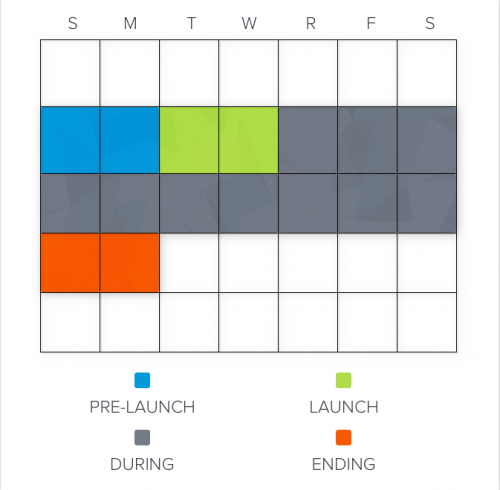
Component #4: The Length of the Giveaway
The higher the value of the prize, the longer the giveaway should run. This is usually our advice to new hosts, but you should test it for your business. You could find keeping your giveaways short maintains enthusiasm throughout the campaign and helps queue up excitement for your next giveaway.
Only giving away a few t-shirts? Running this giveaway for a few months is a bit much. Giving away an all expenses paid vacation to Disney World? Running this giveaway for a few days would be a waste.
Component #5: The Giveaway’s Promotion Strategy
One of the most important things you can do is develop a solid strategy for promoting your giveaways. Pre-launch promotion is just as important as the actual launch. Building up excitement will increase entries quickly. So, which outlets should you test?
Social media – If you plan to run your giveaway on Facebook, then you should do pre-launch promotions on Facebook. Target the social media channel with your largest following. If you don’t have a huge following on social media just yet, send out an announcement in your newsletter or post it to your blog 48 hours in advance.
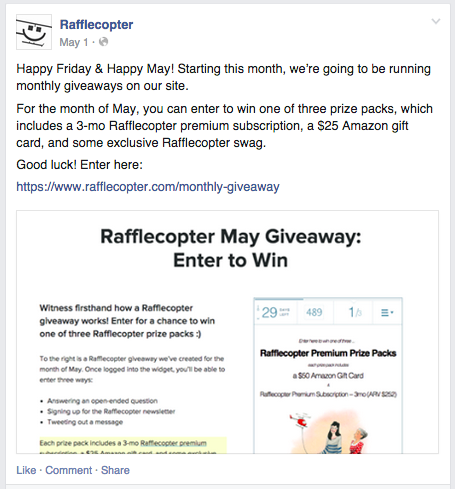
Paid ads – Display ads can be a tricky game, and if you don’t know what you’re doing they can be an expensive game. If you’re at all versed in paid ads, they’re worth a shot for your next giveaway. You can boost a post on Facebook, or you could try the standard newsfeed or sidebar ads. If you go this route, make sure you’re using a highly targeted audience, so you don’t waste your marketing budget.
Blogger outreach – If you’re a brand wanting to run a giveaway campaign–consider bloggers. They’re influencers, and they usually have a large reach. You can pool a group of bloggers, and share the widget with them to amplify your audience. Not only will your giveaway get traffic from their blogs, the bloggers will more than likely share it on social media.
With the Rafflecopter analytics you can see which blogs drove the most traffic. Those are the gems you’ll want to hit up again for your next campaign.
What Else Can Be Tested?
Unless you crushed it with your first giveaway, you probably need to tweak a few things before your next giveaway launch. Test to find out what works with your audience. Giveaway duds are preventable!
What will you test on your next giveaway? Tell us in the comments!
Pingback: The 5-Step Checklist to Launching Your First Giveaway()